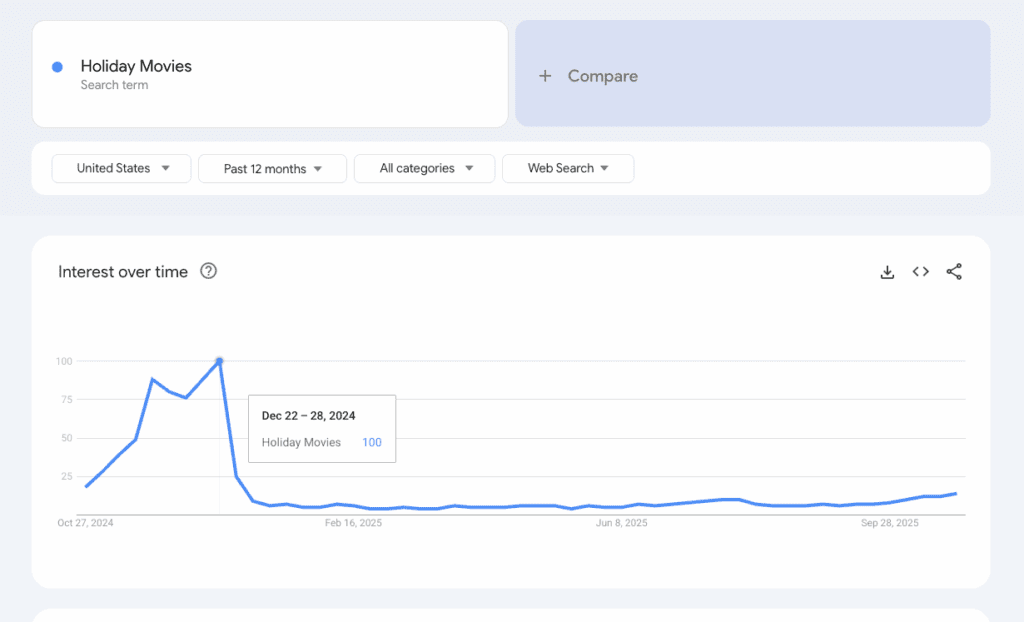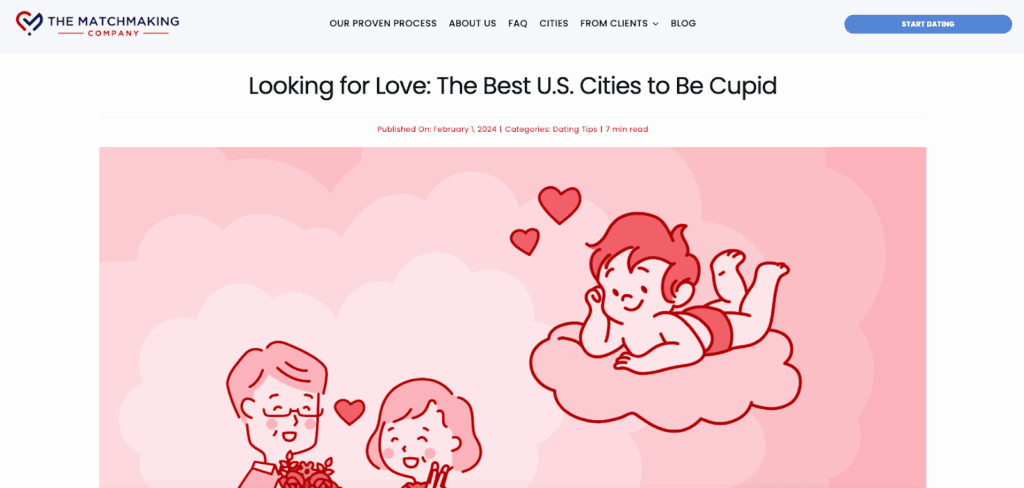Home / Blog / 7 Ways to Use the Holidays to Build Links and Authority
7 Ways to Use the Holidays to Build Links and Authority
Published: November 04, 2025
Share on LinkedIn Share on Twitter Share on Facebook Click to print Click to copy url

Contents Overview
The holidays are more than shopping moments for consumers, they’re powerful opportunities for digital PR teams. Seasonal trends create predictable waves of media interest, and journalists are always looking for timely, relevant stories that connect with what audiences care about most.
Brands that plan ahead and tap into these cycles can earn consistent, high-quality coverage year after year. Go Fish’s internal data shows that National Day campaigns consistently outperform other formats in both link volume and organic coverage.
1. Define Your Holiday Hook: Major vs. Micro Holidays
There’s a big difference between major holidays and national days. Major holidays like Christmas, Valentine’s Day, and Thanksgiving attract intense competition and saturated media coverage, making it harder for brands to stand out. National days, on the other hand, such as National Margarita Day, National Breakup Day, or National Pizza Day, offer more focused, undercovered opportunities that journalists are still eager to write about.
Resources like TimeAndDate.com and the National Today Calendar make it easy to find upcoming national days that align with your brand or client.
At Go Fish, we’ve seen that national day campaigns often outperform big holiday pushes because they’re niche, relevant, and easier to dominate in search and media conversations. For example:
- “The Most Popular Breakup Food in Every State” – Created for Love Life Academy and pitched around National Breakup Day, earning 59 links by the end of the promotion period.
- “Every State’s Favorite Margarita” – Built for Serve & Savour and tied to National Margarita Day, earning 34 links during its run.
These kinds of targeted, timely campaigns prove that smaller hooks can deliver outsized PR and SEO impact.
2. Capitalize on Built-In Media Demand
Editors and journalists start planning holiday content months before the season begins. Each year, searches for seasonal topics like “holiday movies” and “Thanksgiving food” follow nearly identical patterns, spiking at the same time on Google Trends. This consistency gives brands a clear advantage: by aligning PR campaigns with those predictable search surges, your story is far more likely to earn coverage when journalists are actively looking for related angles.
Adding Google Trends visuals for terms like holiday movies and Thanksgiving food helps illustrate just how reliable these patterns are.
To stay ahead, monitor newsroom and search behavior using tools like BuzzSumo, Google Trends, Exploding Topics, or keyword data from your SEO platform. Tracking when interest in seasonal topics starts to rise allows you to pitch at the right moment, early enough for editors to plan coverage, but close enough to the spike to stay relevant.


3. Match the Holiday to Your Brand’s Message
The strongest holiday campaigns don’t always promote a product directly, they connect to the season’s broader themes in ways that feel natural to the brand. Instead of forcing a sales angle, they align tangentially with brand values such as connection, generosity, or nostalgia.
For example:
- Valentine’s Day: Focused on love, relationships, and giving. The Matchmaking Company’s “Best Cities to Be Cupid” tied perfectly into those themes while reinforcing their expertise in relationships.
- Christmas: Centered on spending, nostalgia, and togetherness. SimpleTexting’s “Get Paid to Binge-Watch Holiday Movies” tapped into the comfort of holiday traditions and the cultural obsession with seasonal films.
- Thanksgiving: Built around food, family, and tradition. Shane Co.’s “Each State’s Ideal Thanksgiving Plate” connected emotion and data in a way that was timely, visual, and highly shareable.
Campaigns like these work because they feel genuine to the brand, add value to seasonal conversations, and give journalists something relevant to cover year after year.



4. Build a Holiday Digital PR Calendar
Lead time can make or break a holiday campaign. Journalists start planning their seasonal coverage weeks or even months in advance, so brands that wait until the holiday is trending are already too late. Getting ahead of that editorial cycle ensures your pitch lands right when editors are finalizing their story lists.
A general timeline to follow:
- Valentine’s Day: Pitch by late January.
- Easter: Pitch by early March.
- Halloween: Pitch by early September.
- Thanksgiving and Christmas: Pitch by early November.
Building a shared PR calendar in Google Sheets is one of the easiest ways to stay organized. Map out each holiday, potential campaign ideas, and outreach windows so your team can coordinate early. This approach helps you plan proactively, align with editorial deadlines, and consistently land coverage when interest is at its peak.
5. Find Your Hook: Data, Surveys, or Emotional Angles
Holiday campaigns tend to perform best when they use proven, data-driven formats that give journalists something fresh, visual, and easy to write about. The most successful approaches fall into three main categories: data studies, surveys, and city rankings. Each ties real insights to seasonal moments in ways that resonate with both media and audiences.
Data Studies
Data-led stories are a natural fit for holiday coverage because they blend cultural relevance with measurable insights. Examples include:
- “Every State’s Favorite Holiday Food, Drink, or Gift”
- “The Cost of Running Holiday Lights in Every State”
For example, Mr. Electric’s “The Cost of Running Holiday Lights in Every State” earned 33 links during its promotion period. The Go Fish team analyzed residential electricity rates from the U.S. Energy Information Administration (EIA) to calculate how much it costs to power light displays across every state. Using average wattage and three decoration levels—typical, heavy, and enthusiastic—the data revealed where festive cheer shines brightest (and priciest).
Surveys
Surveys help brands tell a human story around holiday experiences, attitudes, or spending. They perform well because they add emotion and personal context to seasonal trends.
For example, Deputy’s “The Holiday Season, According to Retail & Hospitality Workers” earned 23 links during its promotion period. The campaign surveyed over 500 retail and hospitality workers and more than 2,100 consumers to understand how the holidays impact both sides of the counter, covering staffing, job satisfaction, shopper patience, and spending habits. The findings highlighted the real pressures and perks behind the busiest time of year.
City Rankings
City rankings create immediate visual interest and geographic appeal, making them highly linkable for local outlets.
For example, Chicco’s “The Best U.S. Cities for Trick-or-Treating“ earned 16 links during its promotion period. The Go Fish team analyzed 100 of the largest U.S. cities across 13 ranking factors, including child population, walkability, candy stores, and neighborhood density, to identify where families can enjoy the sweetest and safest Halloween experience.
Why These Formats Work
Journalists prefer stories that bring fresh data and a seasonal twist, even for topics that repeat each year. A creative angle, paired with timely insights, gives them something new to cover while staying within a familiar seasonal framework.
At Go Fish, we’ve seen that campaigns like these consistently outperform traditional press pushes because they balance relevance, novelty, and newsworthiness, the three ingredients editors look for in every strong holiday story.
6. Research Journalists Who Love Holiday Angles
Many reporters return to the same seasonal beats year after year, covering familiar angles like gift trends, travel plans, or holiday spending habits. Keeping tabs on who covers these topics can help you reach the right person before their inbox fills up.
Set MuckRack alerts or use Google News searches to monitor which journalists are publishing around your target themes. Tracking their bylines over time reveals when they typically start writing seasonal pieces and what formats resonate most.
Your best chance at a placement is pitching the right story to the right reporter at the right time.
When you combine smart timing with a relevant pitch and a data-driven angle, your outreach stops feeling like cold pitching and starts aligning with what journalists actually need.



7. Repurpose & Refresh Holiday Content Year After Year
Seasonal campaigns don’t have to be one-and-done efforts. When planned strategically, they can evolve into long-term assets that grow stronger each year. Refreshing your data, updating visuals, and re-optimizing for new keywords can turn a single win into an annual traffic and PR driver.
Take Mr. Electric’s “Cost of Running Holiday Lights” as an example. This campaign can easily be refreshed every year with new EIA electricity rate data. Each update gives journalists an incentive to cover it again and reinforces your brand’s authority on the topic.
To build on that momentum, link related seasonal campaigns internally to strengthen topical authority and help search engines understand your expertise. Creating a holiday content archive—organized by theme, date, and performance, also makes it easy for your PR and content teams to revisit successful ideas, update the assets, and re-pitch them to new outlets the following year.
Seasonal timing drives natural media interest.
Journalists expect holiday angles. Tying your campaigns to timely events increases both relevance and coverage potential. Go Fish’s internal data shows that seasonal campaigns earned an 89% organic pickup rate, proving that timing is one of the most powerful levers for success.
Niche holidays create bigger wins.
National days like National Margarita Day or National Pizza Day often drive more links than major holidays. They’re niche, less saturated, and offer higher novelty, perfect conditions for a story that stands out.
Planning early pays off.
Holiday coverage calendars fill quickly. Pitching 3–6 weeks in advance can be the difference between a story that lands and one that gets buried.
Data and emotion make the perfect mix.
The best-performing campaigns blend data-backed insights, costs, rankings, or surveys, with emotional resonance. Content that taps into family, nostalgia, or humor earns both trust and attention.
Internal data is your differentiator.
Proprietary insights and performance metrics help your campaigns stand out. Journalists value credible, first-party data they can’t find elsewhere.
Storytelling over selling.
The strongest holiday PR campaigns center on universal themes like love, generosity, and celebration. When brands lead with story instead of sales, their content appeals to a wider range of publications and audiences.
Start Now
Holiday campaigns that perform best start months before the season begins.
Whether you’re planning your next National Day activation or preparing data for a full-scale Christmas feature, the best time to start is today. Connect with Go Fish’s Digital PR Team to map your next seasonal campaign and turn timely ideas into long-term visibility.
About Lanie Martin
Lanie Martin is a Digital PR Manager specializing in strategy, planning, and execution of high-impact campaigns. She’s produced 100+ campaigns for 30+ clients across industries and leads Go Fish Digital’s internship program, mentoring the next generation of PR professionals.
MORE TO EXPLORE
Related Insights
More advice and inspiration from our blog
Ignoring Local SEO in 2026 Is Costing You Customers
Go Fish Digital shares expert local SEO strategies for 2026 and...
Celeste Rodriguez| November 14, 2025
SEO for Enterprise Businesses: Scalable Strategies that Drive Revenue
Discover how enterprise brands scale SEO with governance, automation, and cross-team...
Kimberly Anderson-Mutch| November 05, 2025
Location-Based Search Results: How Geographic Targeting Changes Google Rankings
A comprehensive study revealing how Google’s location-based algorithm personalizes search results...
Dan Hinckley| October 24, 2025





